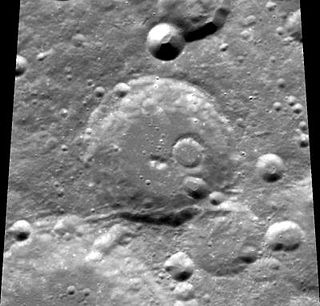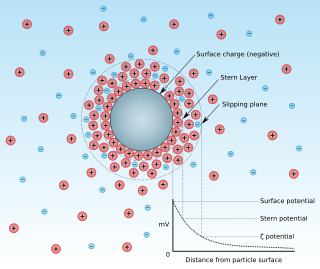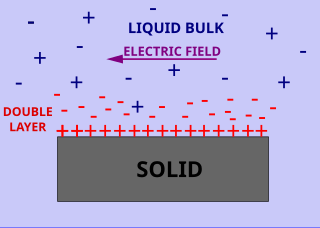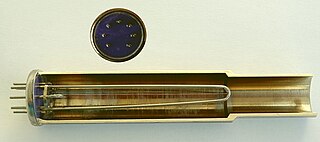
Brownian motion or pedesis is the random motion of particles suspended in a fluid resulting from their collision with the fast-moving molecules in the fluid.

Theodor ("The") Svedberg was a Swedish chemist and Nobel laureate for his research on colloids and proteins using the ultracentrifuge, active at Uppsala University.

Electrophoresis is the motion of dispersed particles relative to a fluid under the influence of a spatially uniform electric field. Electrophoresis of positively charged particles (cations) is sometimes called cataphoresis, while electrophoresis of negatively charged particles (anions) is sometimes called anaphoresis.

In the philosophy of thermal and statistical physics, the Brownian ratchet or Feynman-Smoluchowski ratchet is an apparent perpetual motion machine first analysed in 1912 as a thought experiment by Polish physicist Marian Smoluchowski and popularised by American Nobel laureate physicist Richard Feynman in a physics lecture at the California Institute of Technology on May 11, 1962, during his Messenger Lectures series The Character of Physical Law in Cornell University in 1964 and in his text The Feynman Lectures on Physics as an illustration of the laws of thermodynamics. The simple machine, consisting of a tiny paddle wheel and a ratchet, appears to be an example of a Maxwell's demon, able to extract useful work from random fluctuations (heat) in a system at thermal equilibrium in violation of the second law of thermodynamics. Detailed analysis by Feynman and others showed why it cannot actually do this.

Paneth is a lunar impact crater that is located on the far side of the Moon, just beyond the northwestern limb. It lies just to the north-northeast of the crater Smoluchowski, and to the east-southeast of Boole on the near side.

Zeta potential is a scientific term for electrokinetic potential in colloidal dispersions. In the colloidal chemistry literature, it is usually denoted using the Greek letter zeta (ζ), hence ζ-potential. The usual units are volts (V) or millivolts (mV). From a theoretical viewpoint, the zeta potential is the electric potential in the interfacial double layer (DL) at the location of the slipping plane relative to a point in the bulk fluid away from the interface. In other words, zeta potential is the potential difference between the dispersion medium and the stationary layer of fluid attached to the dispersed particle.

Critical opalescence is a phenomenon which arises in the region of a continuous, or second-order, phase transition. Originally reported by Charles Cagniard de la Tour in 1823 in mixtures of alcohol and water, its importance was recognised by Thomas Andrews in 1869 following his experiments on the liquid-gas transition in carbon dioxide, many other examples have been discovered since. The phenomenon is most commonly demonstrated in binary fluid mixtures, such as methanol and cyclohexane. As the critical point is approached, the sizes of the gas and liquid region begin to fluctuate over increasingly large length scales. As the density fluctuations become of a size comparable to the wavelength of light, the light is scattered and causes the normally transparent liquid to appear cloudy. Tellingly, the opalescence does not diminish as one gets closer to the critical point, where the largest fluctuations can reach even centimetre proportions, confirming the physical relevance of smaller fluctuations.

Smoluchowski is a lunar impact crater on the far side of the Moon. It lies in the part of the lunar surface that is sometimes brought into view of the Earth during periods of favorable libration and illumination from sunlight, but at such times little detail can be seen as the crater is observed from the edge. Smoluchowski lies across the northern rim of the larger walled plain Poczobutt. Nearly attached to the north-northeastern outer rim of Smoluchowski is the smaller crater Paneth.

Rouleaux are stacks or aggregations of red blood cells (RBCs) which form because of the unique discoid shape of the cells in vertebrates. The flat surface of the discoid RBCs gives them a large surface area to make contact with and stick to each other; thus forming a rouleau. They occur when the plasma protein concentration is high, and because of them the ESR is also increased. This is a non-specific indicator of the presence of disease.
Electroacoustic phenomena arise when ultrasound propagates through a fluid containing ions. The associated particle motion generates electric signals because ions have electric charge. This coupling between ultrasound and electric field is called electroacoustic phenomena. The fluid might be a simple Newtonian liquid, or complex heterogeneous dispersion, emulsion or even a porous body. There are several different electroacoustic effects depending on the nature of the fluid.

Surface conductivity is an additional conductivity of an electrolyte in the vicinity of charged surfaces. Close to charged surfaces a layer of counter ions of opposite polarity exists which is attracted by the surface charges. This layer of higher ionic concentration is a part of the interfacial double layer. The concentration of the ions in this layer is higher as compared to the volume conductivity far from the charged surface and leads to a higher conductivity of this layer.

The Pirani gauge is a robust thermal conductivity gauge used for the measurement of the pressures in vacuum systems. It was invented in 1906 by Marcello Pirani.
The convection–diffusion equation is a combination of the diffusion and convection (advection) equations, and describes physical phenomena where particles, energy, or other physical quantities are transferred inside a physical system due to two processes: diffusion and convection. Depending on context, the same equation can be called the advection–diffusion equation, drift–diffusion equation, or (generic) scalar transport equation.

Roman Smoluchowski was a notable physicist who worked in Poland, and after World War II settled in Institute for Advanced Study at Princeton. He was the son of the statistical physics pioneer Marian Smoluchowski. In 1974, Roman Smoluchowski was awarded a Guggenheim Fellowship. In 1984, the minor planet 4530 Smoluchowski was named after him.













